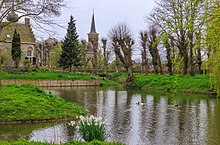
Back Vywer Afrikaans Basetón AN بركة (مياه) Arabic Estanque AST Weiher BAR Kulam BDR Kulam BJN পুকুর Bengali/Bangla Estany (embassament) Catalan Stôw CSB



A pond is a small, still, land-based body of water formed by pooling inside a depression, either naturally or artificially. A pond is smaller than a lake[1] and there are no official criteria distinguishing the two, although defining a pond to be less than 5 hectares (12 acres) in area, less than 5 metres (16 ft) in depth and with less than 30% of its area covered by emergent vegetation helps in distinguishing the ecology of ponds from those of lakes and wetlands.[2][3]: 460 Ponds can be created by a wide variety of natural processes (e.g. on floodplains as cutoff river channels, by glacial processes, by peatland formation, in coastal dune systems, by beavers), or they can simply be isolated depressions (such as a kettle hole, vernal pool, prairie pothole, or simply natural undulations in undrained land) filled by runoff, groundwater, or precipitation, or all three of these.[4] They can be further divided into four zones: vegetation zone, open water, bottom mud and surface film.[3]: 160–163 The size and depth of ponds often varies greatly with the time of year; many ponds are produced by spring flooding from rivers. Ponds are usually freshwater but may be brackish in nature. Saltwater pools, with a direct connection to the sea to maintain full salinity, may sometimes be called 'ponds' but these are normally regarded as part of the marine environment. They do not support fresh or brackish water-based organisms, and are rather tidal pools or lagoons.
Ponds are typically shallow water bodies with varying abundances of aquatic plants and animals. Depth, seasonal water level variations, nutrient fluxes, amount of light reaching the ponds, the shape, the presence of visiting large mammals, the composition of any fish communities and salinity can all affect the types of plant and animal communities present.[5] Food webs are based both on free-floating algae and upon aquatic plants. There is usually a diverse array of aquatic life, with a few examples including algae, snails, fish, beetles, water bugs, frogs, turtles, otters, and muskrats. Top predators may include large fish, herons, or alligators. Since fish are a major predator upon amphibian larvae, ponds that dry up each year, thereby killing resident fish, provide important refugia for amphibian breeding.[5] Ponds that dry up completely each year are often known as vernal pools. Some ponds are produced by animal activity, including alligator holes and beaver ponds, and these add important diversity to landscapes.[5]
Ponds are frequently man made or expanded beyond their original depths and bounds by anthropogenic causes. Apart from their role as highly biodiverse, fundamentally natural, freshwater ecosystems ponds have had, and still have, many uses, including providing water for agriculture, livestock and communities, aiding in habitat restoration, serving as breeding grounds for local and migrating species, decorative components of landscape architecture, flood control basins, general urbanization, interception basins for pollutants and sources and sinks of greenhouse gases.
- ^ STANLEY, E. G. (1 June 1975). "The Merriam-Webster Dictionary – The Oxford Illustrated Dictionary". Notes and Queries. 22 (6): 242–243. doi:10.1093/nq/22-6-242. ISSN 1471-6941.
- ^ David C. Richardson; Meredith A. Holgerson; Matthew J. Farragher; Kathryn K. Hoffman; Katelyn B. S. King; María B. Alfonso; Mikkel R. Andersen; Kendra Spence Cheruveil; Kristen A. Coleman; Mary Jade Farruggia; Rocio Luz Fernandez; Kelly L. Hondula; Gregorio A. López Moreira Mazacotte; Katherine Paul; Benjamin L. Peierls; Joseph S. Rabaey; Steven Sadro; María Laura Sánchez; Robyn L. Smyth; Jon N. Sweetman (2022). "A functional definition to distinguish ponds from lakes and wetlands". Scientific Reports. 12 (1): 10472. Bibcode:2022NatSR..1210472R. doi:10.1038/s41598-022-14569-0. PMC 9213426. PMID 35729265.
- ^ a b Clegg, J. (1986). Observer's Book of Pond Life. Frederick Warne, London
- ^ Clegg, John, 1909-1998. (1986). The new observer's book of pond life (4th ed.). Harmondsworth: Frederick Warne. ISBN 0-7232-3338-1. OCLC 15197655.
{{cite book}}: CS1 maint: multiple names: authors list (link) CS1 maint: numeric names: authors list (link) - ^ a b c Keddy, Paul A. (2010). Wetland ecology: principles and conservation (2nd ed.). Cambridge: Cambridge University Press. ISBN 978-1-139-22365-2. OCLC 801405617.